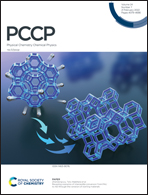The role of defects presenting in graphitic SiC sheets and their consequences in the exfoliation of layers – a first principles approach†
Abstract
Recently, there has been a growing interest in exploring new 2D nanostructures, due to their unique electronic and optical properties. An atomically thin SiC sheet, which has a honeycomb structure similar to BN, as well as being a direct band gap semiconductor, is one such candidate. Despite several theoretical reports predicting the structural and dynamical stability of 2D SiC nanostructures, few experimental reports have been reported so far. In the present work, we demonstrated by employing first principles density functional theory calculations that the role of self defects on the exfoliation of SiC layers can be understood by studying monolayer, bilayer and trilayer 2D SiC systems. From our work, it can be seen that the dangled C atom on the removal of a Si atom in the SiC layer prefers to interact with an adjacent layer, owing to the compensation of the charges, whereas, a dangled Si atom (in the carbon vacancy case) in the SiC layer compensates its additional charge within the layer by forming a Si–Si bond. We concluded that the exfoliation process of SiC is significantly affected by Si vacancies, rather than the presence of carbon vacancies. This work also provides an intuitive idea to synthesise 2D SiC nanostructures as it has interesting structural and electronic properties.



 Please wait while we load your content...
Please wait while we load your content...